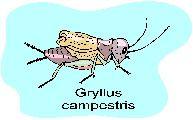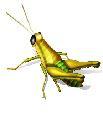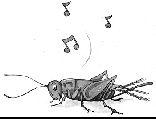Natural Solutions to Things That Bug You (71 page)
Read Natural Solutions to Things That Bug You Online
Authors: Myles Bader

GIVE THEM THE OLD PEPPER SPRAY
A spray that combines onion, garlic and hot pepper will eliminate these pests in very short order. If you are doing a large lawn area a soap spray will work best.
¼ Cup Tabasco Sauce™
1 Medium onion
4 Cups of warm tap water
7 Cloves of garlic
1 Teaspoon of Ivory Liquid Soap™
Place the garlic, peppers or Tabasco Sauce™, onion and 2 cups of water into a food processor and blend well. Allow it to stand for 24 hours, strain and add the balance of the water and the soap. Spray both sides of the leaves.
THERE’S A CHINCH FUNGUS AMONG US
 A new strain of fungus in now available commercially called
A new strain of fungus in now available commercially called
Beauveria bassiana
that will kill the chinch bugs.
CRICKETS
General Information:
 Crickets are a member of the cockroach family, the noisiest member. They will look for a warm location when the weather starts to get cold and can be a real pest. However, in many societies around the world they are considered lucky and are never killed or disturbed.
Crickets are a member of the cockroach family, the noisiest member. They will look for a warm location when the weather starts to get cold and can be a real pest. However, in many societies around the world they are considered lucky and are never killed or disturbed.
BAITS DO WORK
Place some molasses balls containing 5% food-grade DE or use borax or Comet®. This will kill them without a problem.
Make sure all baits are out of reach of pets and children at all times.
A LITTLE SQUIRT WILL DO YA
You can prepare a spray that will kill the crickets in about 30 seconds if sprayed on them. Just mix 1 ounce of dishwasher soap in 1 quart of water. If you prefer to use vinegar use 4 ounces in 1 quart of water and it will kill them in about 60 seconds.
MOLE CRICKETS ARE SNEAKY
 Mole crickets fly into the garden at night usually on very cloudy days and are drawn to light. These are large crickets and are about 1¼-inches long with sturdy shovel-like forelegs for digging into the soil. The northern mole cricket is a brownish-gray and the southern ones are usually more pinkish. They are most active in moist, warm weather and their tunnel tends to cut off the roots of seedlings. All deterrents that work for grasshoppers should be used.
Mole crickets fly into the garden at night usually on very cloudy days and are drawn to light. These are large crickets and are about 1¼-inches long with sturdy shovel-like forelegs for digging into the soil. The northern mole cricket is a brownish-gray and the southern ones are usually more pinkish. They are most active in moist, warm weather and their tunnel tends to cut off the roots of seedlings. All deterrents that work for grasshoppers should be used.
EARWIGS

General Information:
 Earwigs; are a relative of the cockroach with over 1,000 species known worldwide. They love to feed on plants and can be a real pest in greenhouses. They do feed on aphids and are sometimes considered a beneficial insect.
Earwigs; are a relative of the cockroach with over 1,000 species known worldwide. They love to feed on plants and can be a real pest in greenhouses. They do feed on aphids and are sometimes considered a beneficial insect.
Earwigs are among the most frequently recognized insect pests in home gardens. Although they can devastate seedling vegetables or annual flowers and often seriously damage maturing soft fruit or corn silks, they also have a beneficial role in the landscape and have been shown to be important predators of aphids.
Although several species occur, the most common in California gardens is he European earwig, which was accidentally introduced into North America from Europe in the early 1900s.
The striped earwig occurs in southern California and can annoy residents when it is attracted to lights. It has a very disagreeable odor when crushed. However, the striped earwig does not damage plants.
The adult earwig is readily identified by a pair of prominent appendages that resemble forceps at the tail end of its body. Used for defense, the forceps are somewhat curved in the male but straighter in the female. The adult body is about ¾-inch long and reddish brown.
Many species have wings that are under short, hard wing covers, but they seldom fly. Immature earwigs are similar to adults except are smaller and lack wings. Earwigs do not attack humans!
Earwigs feed mostly at night and seek out dark, cool, moist places to hide during the day. Their favorite hiding places are under loose clods of soil, boards, dense growth of vines or weeds, or even within fruit damaged by other pests such as snails, birds, or cutworms.
Female earwigs dig cells in the ground where they lay masses of 30 or more eggs. Eggs hatch into small, white nymphs and remain in the cell protected and fed by their mother until their first molt. Later nymphs are darker and forage on their own.
Generally there is one generation a year, but females produce two broods. Part of the earwig population hibernates during the winter as pairs buried in cells in the soil. In milder California climates, some remain active all year.
Earwigs may seek refuge indoors when conditions outside are too dry or hot or cold. Large accumulations of earwigs can be annoying but present no health hazards. Sweep or vacuum them up and seal entry points. Earwigs eventually die indoors because there is little for them to eat.
Management of earwigs requires an integrated program that takes advantage of their habitat preferences. As moisture-loving insects, earwigs would not normally thrive in California’s arid climate without the moisture and shade provided by the irrigated garden. Where earwigs are a problem, consider reducing hiding places and surface moisture levels.
EARWIGS LOVE TUNA
A key element of an earwig management program is trapping. Scatter numerous traps throughout the yard and in the house if a problem exists. Traps can easily be hidden near shrubbery and ground cover plantings, or against fences.
A low-sided can, such as a cat food or tuna fish can, with ½-inch of oil in the bottom makes an excellent trap. Tuna fish oil is very attractive to earwigs or vegetable oil with a drop of bacon grease can be used.
A TUBULAR EXPERIENCE
Save your paper towel and toilet paper cardboard tubes to use as traps for earwigs. Stuff them with straw and the little pests will hide there and make it easy for you to locate and dispose of them. If you spray areas where they frequent with a soapy solution you can get rid of them that way as well.

SHOOT THE LITTLE DEVILS
A dishwasher detergent soap mixed with water in a spray bottle will kill earwigs upon contact. Use 1 ounce per spray bottle of water. To find them go looking after dark with a flashlight and the spray bottle in your holster.
TRAPS WORK GREAT
If you plan on trapping the earwigs, place a shallow dish or tuna can that is buried so that it is level with the ground, they are real lazy and will not work too hard for a meal. Place some honey and peanut butter laced with borax in the dish. You can also use food-grade DE if you have some handy.
STICKY-SIDE UP
Earwigs will not cross a piece of tape with the sticky side up or Vaseline®.
HEAVY DRINKERS
Earwigs love beer and if you leave a shallow dish around in the evening where they frequent, you will find the dish full of earwigs in the morning.
HERE LITTLE EARWIG
Chickens love to eat earwigs and will snoop all over the place looking for them. If you have a few chickens you will never have an earwig problem.
GRUBS
GARLIC VS GRUBS
 Finely mince 5 garlic cloves and allow it to dry then crush into a powder. Place the powder in 2 teaspoons of water and allow it to stand for 2 hours.
Finely mince 5 garlic cloves and allow it to dry then crush into a powder. Place the powder in 2 teaspoons of water and allow it to stand for 2 hours.